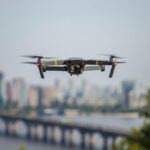Insights from a Drone Expert
As an experienced drone operator, one question I often encounter is:
“Is it possible to fly in the rain?”
The straightforward answer is: yes, it is technically possible — but in most cases, it is not advisable.
Let’s take a deeper look at why.
The Risks of Flying in Rain
The majority of drones on the market today, particularly those used for aerial photography and general commercial work, are not designed to withstand wet conditions. While a few light drops might not cause immediate failure, exposure to rain increases the risk of:
- Short circuits within critical electronic components.
- Motor failure due to water ingress.
- Sensor interference, especially with vision systems and obstacle detection.
- Corrosion over time, significantly reducing the drone’s operational lifespan.
Water infiltration into the flight controller or battery compartments can lead to catastrophic failures — often without warning.
Drones Designed for Adverse Weather
There are exceptions. Certain enterprise-grade drones are built with IP (Ingress Protection) ratings to withstand rain, dust, and harsher environments. For example:
- The DJI Matrice 300 RTK offers an IP45 rating, allowing it to operate in light to moderate rain.
- Some drones used for inspection, emergency response, and industrial applications are specifically engineered for adverse conditions.
However, even with weather-resistant platforms, it’s important to note that performance can still be compromised. Rain affects aerodynamics, sensor accuracy, and propulsion efficiency.
Operational Considerations Beyond Water Resistance
Flying in rain introduces several operational challenges:
- Reduced Visibility: Rain, combined with low cloud cover and fog, can make maintaining visual line of sight (VLOS) extremely difficult — which is a legal requirement under most aviation regulations (such as the UK CAA, FAA Part 107 in the US, and EASA in Europe).
- Compromised Imaging: Raindrops on the camera lens or gimbal can render footage unusable, undermining the entire purpose of a photographic or inspection mission.
- Wind Conditions: Rain rarely occurs without accompanying gusty or turbulent winds, further complicating control and increasing battery consumption.
Best Practices for Professional Pilots
As a professional operator, the priority must always be safety, asset preservation, and mission success.
Unless you are operating a drone rated for adverse weather — and the mission demands it — it is best practice to avoid flying in rain.
If weather conditions deteriorate mid-flight:
- Land immediately in a safe and controlled manner.
- Dry and inspect the aircraft thoroughly.
- Log the incident as part of your operational record for accountability and maintenance tracking.
Conclusion
While modern drone technology has advanced dramatically, rain remains a serious operational hazard for most UAV platforms. Professional pilots must exercise sound judgement, adhere to manufacturer guidelines, and prioritize the safety of equipment, personnel, and airspace users.
When in doubt: postpone the flight.
Clear skies are always worth the wait.






